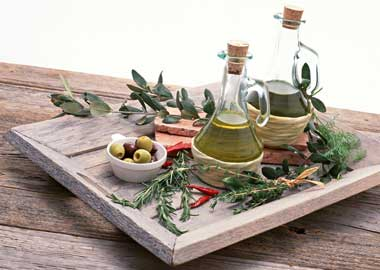
Wild spring greens (ye cai), often considered weeds, are traditionally popular in China as a springtime tonic and they have numerous uses in traditional Chinese medicine. They are mostly "cold" (yin) energy foods and are usually cooked, though some are enjoyed raw.
They include purslane or pigweed, dandelion, shepherd's purse, pig's thigh, field sow's thistle, ferns, daisy leaves and stems. Many are so common that they grow along roadsides, ignored by most people.
These greens are increasingly popular as a health food that provides protein, vitamins and micronutrients. Some are also said to be naturally insect-repellent and thus need no pesticides in cultivation.
Some are available in Western-style supermarkets, such as dandelion, shepherd's purse, daisy leaves and others. Chinese markets sell the others.
Include them sparingly in your spring diet with other fresh greens - they are potent.
TCM classifies these wild greens as "cold" food, good for dispelling pathogenic heat, soothing inflammation, and acting as a diuretic. Some can aid in treatment of high blood pressure (since they are diuretics and many contain omega-3 acids), some are anti-microbial.
Many Chinese people want to eat more wild vegetables because of concerns about pesticides and fertilizers used in most commercial vegetable growing. Many people believe they are naturally uncontaminated because insects are said to avoid them. But don't take this for granted.
Many wild vegetables contain very high amounts of vitamin C, beta-carotene, omega-3 fatty acids, calcium, folate, iron, zinc, copper, phosphorus, magnesium and other nutrients.
More than 6,000 varieties of wild vegetables grow in China and around 100 of them are common in Chinese cuisine. They are usually made into cold dishes with dressing, quickly fried, made into vegetable soup and used in dumpling stuffing.
Eating too many wild greens may cause diarrhea in those with weak digestive systems. Many are high in oxalic acid and eating too much can limit the body's absorption of calcium.
Common wild vegetables
Dandelion
Pu gong ying greens, or dandelion, are rich in organic acid, fructose, carotene, lactoflavin, potassium and vitamins. They are also anti-bacterial and have been used worldwide in healing for centuries. They are considered a seasonal tonic.
Dandelion is a "neutral" food in TCM. It can help dispel pathogenic heat, eliminate toxins, act as a diuretic, relieve internal inflammation, and protect stomach, liver and gallbladder.
Cold boiled dandelion with salt, vinegar and sesame oil is delicious and nutritious. It can be added to soup and other dishes.
Dandelion with shredded pork
Ingredients: Dandelion (250g), shredded pork (100g), mashed ginger, soy sauce, sugar, starch.
Preparation:
1. Mix pork with salt, soy sauce, sugar and starch.
2. Quickly dip dandelion in boiling water, remove it, let it cool and chop.
3. Fry shredded meat with ginger. Add dandelion at the end.
Function: Helps dispel pathogenic heat, eliminates toxins, nourishes yin and promotes internal fluids. It is recommended to relieve coughing and constipation due to yin deficiency.
Shepherd's purse
Shepherd's purse, or ji cai, is rich in protein, high in iron, carotene, microelements and vitamin C. Glutamic acid can help promote appetite; it can help treat iron-deficiency, chronic urinary tract inflammation and gallstones.
Shepherd's purse is "cold" in TCM. Thus it helps dispel pathogenic heat, relieves swelling, acts as a diuretic, benefits spleen and protects liver. It is taken by those with high blood pressure and liver inflammation.
It can be used in cold dishes, soups or made into dumpling stuffing. Since it is high in oxalic acid, which prevents calcium absorption, it needs to be cooked. If you have weak digestion, don't eat too much.
Cold shepherd's purse salad
Ingredients: Shepherd's purse (500g), cooked sesame (50g), sesame oil, dried soybean curd (25g), winter bamboo shoots (25g), carrots (50g).
Preparation:
1. Separately cook shepherd's purse, winter bamboo shoots and carrots. Let cool.
2. Chop ingredients into fine pieces.
3. Mix ingredients, toss with sesame seeds, salt, sugar, and sesame oil.
Function: Helps dispel pathogenic heat, especially in the liver.
Purslane
Purslane is a common succulent-type flowering ground cover. It's called ma chi cai or horse tooth vegetable because the leaves are said to resemble a horse's tooth. It's known elsewhere as pigweed and little hog weed (used as pig fodder), and Verdolaga.
It has a mild, sweet-sour taste and it's chewy. Egg-shaped leaves are green, stems are green or reddish brown.
Purslane is rich in vitamins, protein, carotene, omega-3 fatty acid, fiber, iron, phosphorus, etc. Rich in noradrenalin, it can be helpful to diabetics; the omega-3 acids protect heart and blood vessels.
As a "cold" food in TCM, it dispels heat, fights heat-related ailments and inflammation, acts as a diuretic, and eliminates toxins. It is prescribed for patients with ulcers, high blood pressure, urinary tract infections and other ailments.
It is usually used in soup, congee and cold dishes. Since it's very "cold," pregnant women should avoid it as it could contribute to miscarriage. It can cause diarrhea in those with "pathogenic cold" in their digestive systems.
Fried purslane with egg
Ingredients: Purslane (30g), eggs (250g), yellow rice wine (5g), salt and soy sauce for seasoning.
Preparation:
1. Wash and soak purslane in warm water for 10 minutes. Chop it into small pieces.
2. Beat eggs and mix with purslane. Add yellow rice wine, salt and soy sauce to taste.
3. Fry.
Function: Purslane reduces pathogenic heat and helps expel toxins; egg helps reinforce energy.
(Shanghai Daily April 21, 2009)